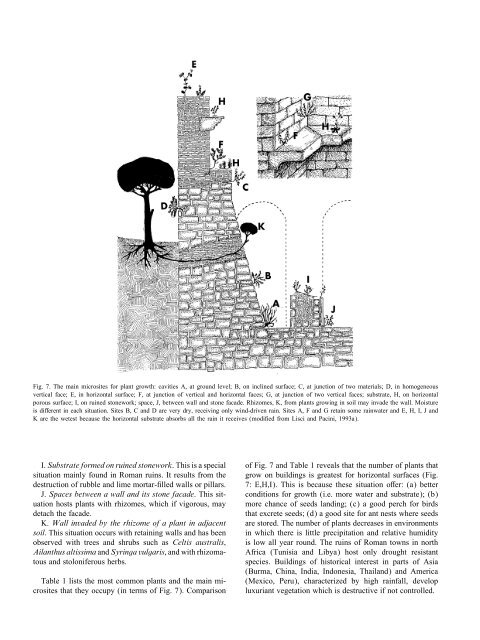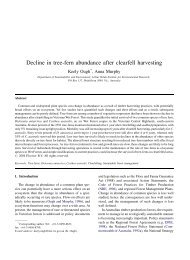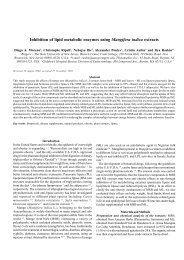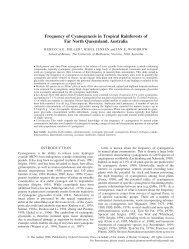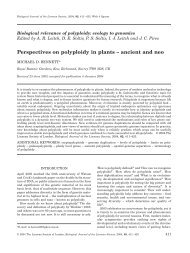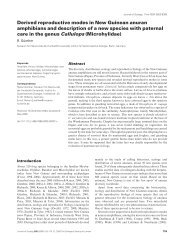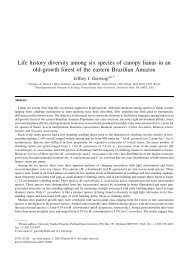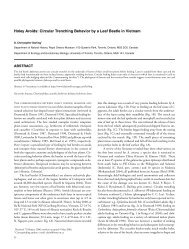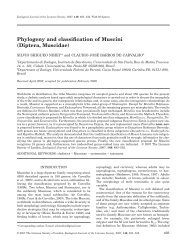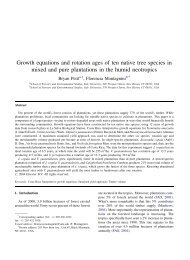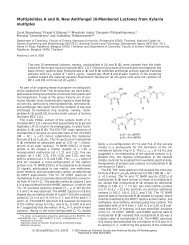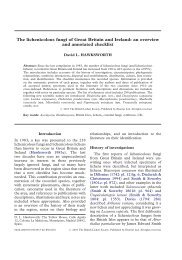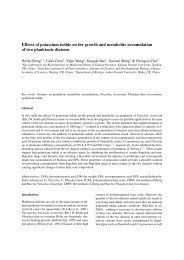Lichens and higher plants on stone: a review - AseanBiodiversity.info
Lichens and higher plants on stone: a review - AseanBiodiversity.info
Lichens and higher plants on stone: a review - AseanBiodiversity.info
Create successful ePaper yourself
Turn your PDF publications into a flip-book with our unique Google optimized e-Paper software.
Fig. 7. The main microsites for plant growth: cavities A, at ground level; B, <strong>on</strong> inclined surface; C, at juncti<strong>on</strong> of two materials; D, in homogeneous<br />
vertical face; E, in horiz<strong>on</strong>tal surface; F, at juncti<strong>on</strong> of vertical <str<strong>on</strong>g>and</str<strong>on</strong>g> horiz<strong>on</strong>tal faces; G, at juncti<strong>on</strong> of two vertical faces; substrate, H, <strong>on</strong> horiz<strong>on</strong>tal<br />
porous surface; I, <strong>on</strong> ruined st<strong>on</strong>ework; space, J, between wall <str<strong>on</strong>g>and</str<strong>on</strong>g> st<strong>on</strong>e facade. Rhizomes, K, from <str<strong>on</strong>g>plants</str<strong>on</strong>g> growing in soil may invade the wall. Moisture<br />
is di erent in eachsituati<strong>on</strong>. Sites B, C <str<strong>on</strong>g>and</str<strong>on</strong>g> D are very dry, receiving <strong>on</strong>ly wind-driven rain. Sites A, F <str<strong>on</strong>g>and</str<strong>on</strong>g> G retain some rainwater <str<strong>on</strong>g>and</str<strong>on</strong>g> E, H, I, J <str<strong>on</strong>g>and</str<strong>on</strong>g><br />
K are the wetest because the horiz<strong>on</strong>tal substrate absorbs all the rain it receives (modi ed from Lisci <str<strong>on</strong>g>and</str<strong>on</strong>g> Pacini, 1993a).<br />
I. Substrate formed <strong>on</strong> ruined st<strong>on</strong>ework. This is a special<br />
situati<strong>on</strong> mainly found in Roman ruins. It results from the<br />
destructi<strong>on</strong> of rubble <str<strong>on</strong>g>and</str<strong>on</strong>g> lime mortar- lled walls or pillars.<br />
J. Spaces between a wall <str<strong>on</strong>g>and</str<strong>on</strong>g> its st<strong>on</strong>e facade. This situati<strong>on</strong><br />
hosts <str<strong>on</strong>g>plants</str<strong>on</strong>g> with rhizomes, which if vigorous, may<br />
detachthe facade.<br />
K. Wall invaded by the rhizome of a plant in adjacent<br />
soil. This situati<strong>on</strong> occurs with retaining walls <str<strong>on</strong>g>and</str<strong>on</strong>g> has been<br />
observed withtrees <str<strong>on</strong>g>and</str<strong>on</strong>g> shrubs suchas Celtis australis,<br />
Ailanthus altissima <str<strong>on</strong>g>and</str<strong>on</strong>g> Syringa vulgaris, <str<strong>on</strong>g>and</str<strong>on</strong>g> withrhizomatous<br />
<str<strong>on</strong>g>and</str<strong>on</strong>g> stol<strong>on</strong>iferous herbs.<br />
Table 1 lists the most comm<strong>on</strong> <str<strong>on</strong>g>plants</str<strong>on</strong>g> <str<strong>on</strong>g>and</str<strong>on</strong>g> the main microsites<br />
that they occupy (in terms of Fig. 7). Comparis<strong>on</strong><br />
of Fig. 7 <str<strong>on</strong>g>and</str<strong>on</strong>g> Table 1 reveals that the number of <str<strong>on</strong>g>plants</str<strong>on</strong>g> that<br />
grow <strong>on</strong> buildings is greatest for horiz<strong>on</strong>tal surfaces (Fig.<br />
7: E,H,I). This is because these situati<strong>on</strong> o er: (a) better<br />
c<strong>on</strong>diti<strong>on</strong>s for growth(i.e. more water <str<strong>on</strong>g>and</str<strong>on</strong>g> substrate); (b)<br />
more chance of seeds l<str<strong>on</strong>g>and</str<strong>on</strong>g>ing; (c) a good perch for birds<br />
that excrete seeds; (d) a good site for ant nests where seeds<br />
are stored. The number of <str<strong>on</strong>g>plants</str<strong>on</strong>g> decreases in envir<strong>on</strong>ments<br />
in which there is little precipitati<strong>on</strong> <str<strong>on</strong>g>and</str<strong>on</strong>g> relative humidity<br />
is low all year round. The ruins of Roman towns in north<br />
Africa (Tunisia <str<strong>on</strong>g>and</str<strong>on</strong>g> Libya) host <strong>on</strong>ly drought resistant<br />
species. Buildings of historical interest in parts of Asia<br />
(Burma, China, India, Ind<strong>on</strong>esia, Thail<str<strong>on</strong>g>and</str<strong>on</strong>g>) <str<strong>on</strong>g>and</str<strong>on</strong>g> America<br />
(Mexico, Peru), characterized by high rainfall, develop<br />
luxuriant vegetati<strong>on</strong> which is destructive if not c<strong>on</strong>trolled.


